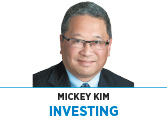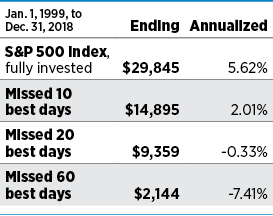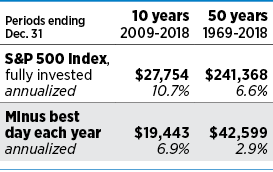Subscriber Benefit
As a subscriber you can listen to articles at work, in the car, or while you work out. Subscribe Now We clearly can’t control trade wars, the markets or White House tweets, but our behavior is up to us.
We clearly can’t control trade wars, the markets or White House tweets, but our behavior is up to us.
Suppose you got spooked last December and sold your stocks as the market’s collapse reached a crescendo on Christmas Eve. Who could blame you, with the talking heads screaming about the “worst December since the Great Depression” and “worst year since the financial crisis”?
Perhaps you eased your pain over the holidays by telling yourself you’d jump back into the market once the bleeding stopped. That sounds reasonable, but if you sat on your hands even a few days, you missed the best January for stocks in 30 years and did yourself great financial harm.
Unfortunately, investors have an uncanny, destructive tendency to buy high (when they’re feeling overconfident) and sell low (when they’re scared).
That’s the message from DALBAR’s 25th annual Quantitative Analysis of Investor Behavior report, which measures the effects of investor decisions to buy and sell. The effects are measured from the perspective of the investor, not the investments themselves, and show the average investor earns less (often much less) than fund performance reports would suggest.
According to DALBAR, “Investor behavior is not simply buying and selling at the wrong time; it is the psychological traps, triggers and misconceptions that cause investors to act irrationally.”
The report identified nine harmful behaviors. Two big ones:
◗ Loss aversion. Behavioral economists have shown the emotional pain of a loss is about twice the pleasure of a gain of the same amount. So, negative experiences will “weigh more heavily and for a longer period of time and be what predominantly shapes the investor’s behavior.” Investors must fight their natural urge to panic when stocks hit an inevitable rough patch.
◗ Availability bias. Investors’ most recent experiences will have the biggest effect on behavior, which is why things tend to go to extremes. During the technology bubble of the late 1990s, investors’ recent experiences led them to see future gains as “being irrationally more probable.”
Successful “market timing” is an expensive fantasy. If you’re going to have long-term success, you have to ride out the bad days to benefit from the good days.
 J.P. Morgan assumed a $10,000 initial investment in the S&P 500 Index for the 20 years ending Dec. 31, 2018, to determine the cost of missing the best days. Importantly, six of the 10 best days were within two weeks of the 10 worst days. Missing just the 10 best days in the 20 years cut your return in half, and you actually lost money if you missed the 20 best days.
J.P. Morgan assumed a $10,000 initial investment in the S&P 500 Index for the 20 years ending Dec. 31, 2018, to determine the cost of missing the best days. Importantly, six of the 10 best days were within two weeks of the 10 worst days. Missing just the 10 best days in the 20 years cut your return in half, and you actually lost money if you missed the 20 best days.
Crandall Pierce looked at the market-timing issue a little differently, assuming you missed the single best day in each year for various periods. Let’s say you made the same $10,000 investment in the S&P 500 on Jan. 1, 1969, stuck it in a drawer and forgot about it. You would have had $241,368 on Dec. 31, 2018.
 If, instead, you tried to “time the market” and missed just the single best day in each of those 50 years, you’d have had less than a fifth of that amount.
If, instead, you tried to “time the market” and missed just the single best day in each of those 50 years, you’d have had less than a fifth of that amount.
My friend Carl Richards coined the term “behavior gap” to label the shortfall between investor returns and investment returns that occur because rising prices attract us and falling prices scare us.
Instead, take your cue from Warren Buffett, who said, “Lethargy bordering on sloth remains the cornerstone of our investment style.”•
__________
Kim is chief operating officer and chief compliance officer for Kirr Marbach & Co. He can be reached at [email protected].
Please enable JavaScript to view this content.
